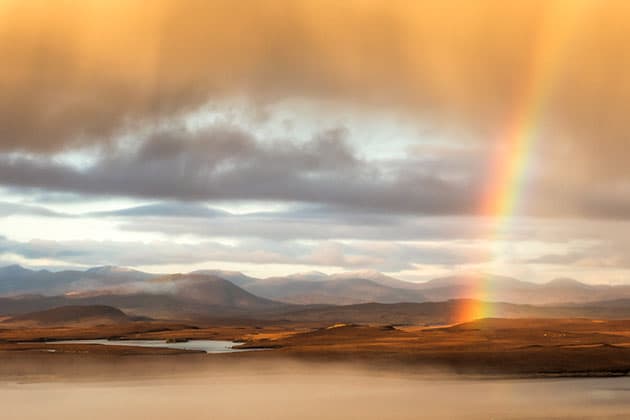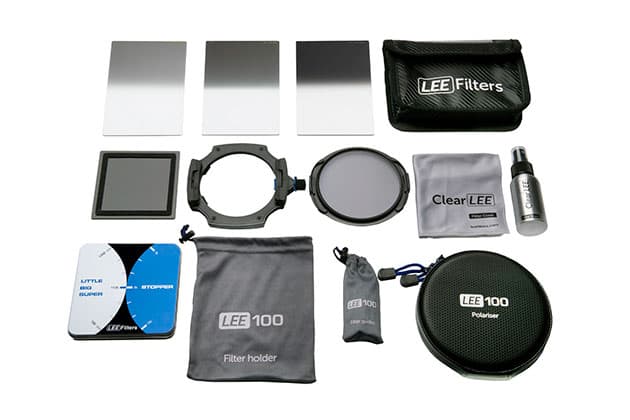There are three filters that every landscape photographer should have in their camera bag: a Neutral Density graduated (ND Grad), Neutral Density (ND), and polariser filter. From capturing a longer exposure time to reducing the glare from a reflective surface, Verity Milligan explains why these are the top 3 filters you need for superb landscape shot.
1. The ND Grad
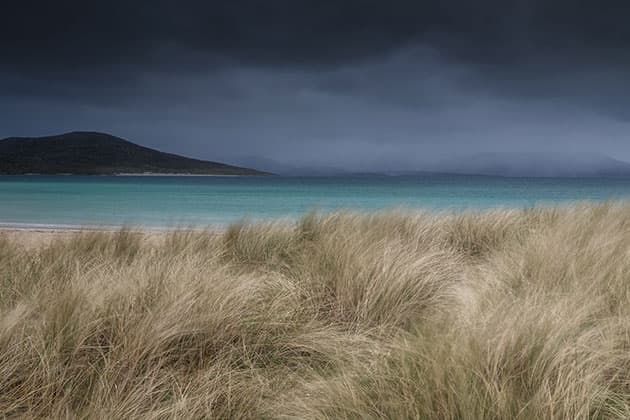
An ND graduated filter enhances this heavy sky and adds atmosphere. Credit: Verity Milligan
A Neutral Density Graduated (ND Grad) filter is like an ND filter but with a gradual blend from dark on the top to clear at the bottom. The top part masks over the sky meaning the exposure time between the sky and land are reading closer exposure values.
Verity says, ‘I use graduated filters when I want to expose for the foreground and keep the correct exposure in the sky. They can be useful when shooting at the beginning or end of the day when the light is low and it can be difficult to maintain good exposure in the foreground and the sky. They can also be very useful if I’m shooting in gloomy/stormy conditions.’ She continues, ‘The advantages to using a grad is the freedom it can give you to shoot in bright conditions and the control over the exposure. Sure, you can replicate it to a certain degree in post, but really this isn’t ideal.’
In terms of disadvantages, Verity advises that you should be careful regarding what situations you deploy them in. ‘For example’, she continues, ‘if you’re shooting a mountain range with an uneven horizon, you can inadvertently end up darkening the mountain peaks and unbalancing the overall exposure.’
Graduated filters come in various strengths and in a soft or hard blend. As you can imagine the soft is more gradual whereas the hard is less so. Which one to choose to use is your decision, as some prefer soft whereas others prefer hard. Verity for the most part opts for soft grads rather than hard because they are a little more forgiving if you’re shooting landscape images. ‘However,’ she says, ‘hard grads can be very useful and effective if you had a defined horizon, for instance if you’re shooting a seascape.’
Finally, when asked if she ever stacks them she replies, ‘I tend not to because it can mean that the sky is almost too dark and ends up looking surreal.’
2. The ND filter
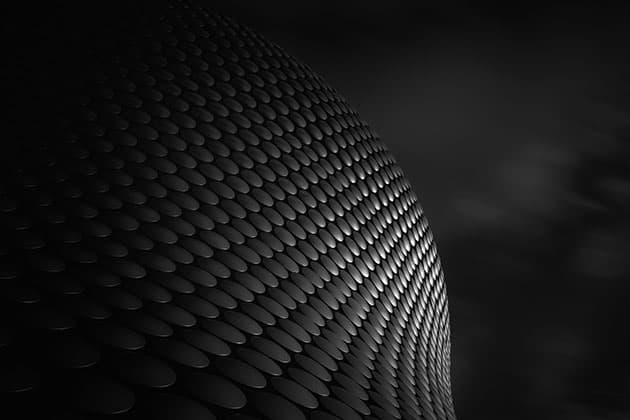
The distinctive exterior of the Selfridges building in Birmingham’s Bullring shopping centre shot with a Neutral Density filter to create this particularly moody and atmospheric image. Credit: Verity Milligan
A Neutral Density (ND filter) comes in various strengths (these are measured in stops). For those who want a versatile option, variable ND filters can alter their strength by spinning – however generally the quality is not so good.
Verity says, ‘For me, an ND filter is useful when I want to show movement in an image. This is particularly useful when I’m shooting architecture and I want to make the imagery more stylised. It’s also very useful when shooting seascapes. In terms of the advantages they definitely help to give an image form. It can be difficult to tell a narrative through a single image, so a sense of movement can be very useful. However, ND filters can be tricky. First, you can find yourself guessing at the time, especially if it’s over five minutes. I advise getting yourself an app to help you calculate the proper timings. Second, there are a few things that can go wrong, such as light leaks through the viewfinder, which can ruin a long exposure.’
3. The polariser
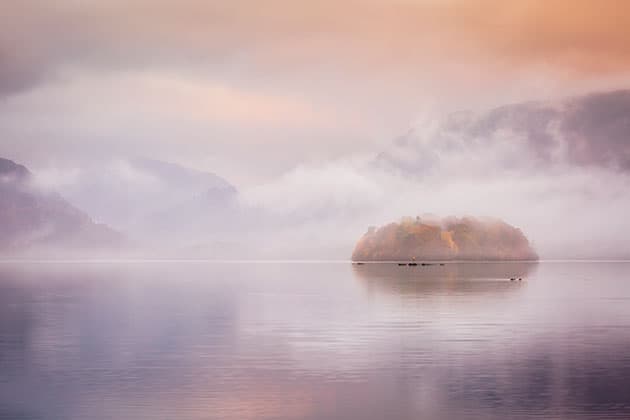
Verity achieved this pinkish-purple, ethereal image of Lake District’s Derwentwater by using a polariser. Credit: Verity Milligan
Finally the polariser is Verity’s favourite and the one she opts for most of the time. ‘For me, a polariser is an essential piece of kit for a landscape photographer. The LEE polariser I use has the advantage of warming up the image, but it also makes the colours pop. It can also be extremely useful for pulling out reflections from bodies of water and reducing reflections if I’m photographing a building.’
Like with the ND and ND Grads, there are advantages and disadvantages to using them, which Verity discusses. ‘Using a polarising filter ensures you have more control of the landscape in front of you, and opens up the possibility of exploring the scene in a different way. However, they can also be difficult to control. If your polariser is in the wrong position you could end up with the sky looking rather strange, and if you’re using one that is attached to a filter holder it creates a small space between the lens and filter which can increase the risk of lens flare if you’re shooting into the light.’
Filter systems

Most professional photographers use the filter holder systems. Credit: Verity Milligan
When it comes to investing in a filter there are two main systems worth picking from. You can either opt for a circular filter, which traditionally screws onto the end of your lens, or a square filter, which slots down a filter holder attached to the front. Most professionals use the holder system, as it can be more versatile and easier to stack filters on top of each other, but they tend to be more expensive. To attach the holder onto your lens you’ll need an adapter ring, which threads onto your lens and then fits to the holder. You’ll need to buy the correct size adapter ring for each of your lenses. The lens thread size is measured in mm, for example 58mm, 67mm, 77mm and 82mm are all common sizes.
The second system is a circular filter that either threads straight onto your lens or can be mounted via a magnetic ring. Again you’ll need to buy the filter (and adapter) in the correct thread size for your lens. You can also purchase step-up and step-down rings if you have multiple lenses with different thread sizes and want to attach the same filter. We recommend you purchase the filter that fits the largest thread size of your lenses, and use step-down rings to fit accordingly. If you step-up, you run the risk of seeing the edge of the filter in the field of view.
Stacking filters
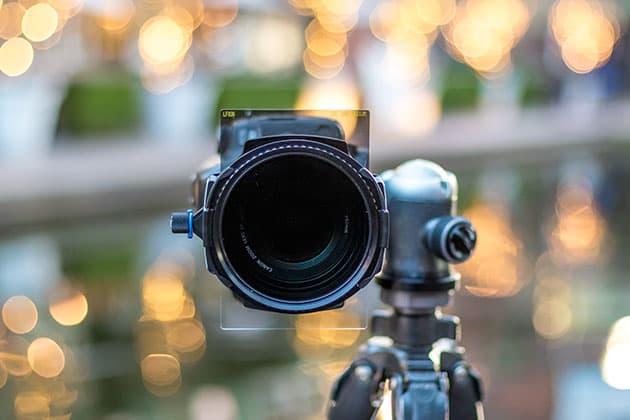
Credit: Verity Milligan
If you find that you need a longer exposure time than your ND filter is capable of, you can stack them together. Verity advises, ‘If I want to have an extremely long exposure and there is a lot of light then I will stack ND filters (usually a 6-stop and a 10-stop), but this can lead to long exposure times and I’m not the most patient of photographers!’ However it’s not just ND filters you can stack together – you can also mix them up, as Verity explains: ‘I’m much more likely to stack an ND grad with other filters such as a graduated and a polariser, that both have a specific purpose when I’m capturing an image.’
Verity’s top filter tips
- Clean regularly – It can be endlessly frustrating when you get home from a shoot and realise that you’ve got lens flare and spots all over that killer image because you haven’t bothered to make sure the filters were clean. When mounting them onto your camera be careful not to leave any fingerprints.
- Less is more – When it comes to graduated filters, I find that less is more. I tend to use a .3 or a .6 rather than a .9 or 1.2. This gives me greater control over the feel of the image and I can always work on the exposure more in post. But if the sky is too dark, then I’m limited to what I can do without creating unnecessary noise in the image.
- Buying – When buying an ND or ND grad filter I would recommend picking up the 100mm square versions that sit in a filter holder. This provides much more versatility and you can use it in conjunction with other filters such as a polariser. Although the screw-in ND filters are much cheaper, you need to buy one (or a step-ring) for each lens filter size and this could become more costly.
- Use wisely – When you first get your hands on ND filters, it can be exciting and you may wish to use them immediately. However, there are certain situations where they are more effective, such as when you’re by the coast or on a particularly windy day. Also, you don’t have to take a really long exposure; sometimes even a one-second long exposure can create something interesting.
- Enhance reflections – Polarising filters can help to get the most out of an image. I’m a fan of using one to enhance the reflections in a scene, especially if I’m shooting next to a lake on a still, misty morning. They can also be extremely useful when capturing images of the coast as you can use them to remove reflections for damp rocks and create a rather interesting foreground. Stacked with other filters they can help create something extraordinary out of the ordinary. They’re also brilliant for pulling out all the colours of a rainbow, if you’re lucky enough to find one!
Kit list
- Polariser – A polariser filter is a landscape photographer’s best friend and will help reduce the glare from reflective surfaces, such as glass and water, and make your sky pop.
- Neutral Density filter – Stop down your exposure time to make creative long exposures with this filter. These come in different strengths or you can also purchase variable ones (which tend to be lower quality but more versatile).
- Neutral Density graduated filter – Match the exposure value of the sky to the ground by darkening it down with a grad. Although the square ND grads are easier to line up they also come in a screw design.
- Full kit – If you want to take your filters seriously then be like Verity and invest in a full filter kit such as the LEE 100 filter kit. These don’t come cheap, but if you take care of them they will last a lifetime and give superb results.
Verity Milligan is a professional landscape photographer based in Birmingham. She has worked on campaigns for organisations such as Yorkshire Tea and Visit Britain. She’s happiest when outdoors, and relishes the opportunity to connect with people, environments and cities.
Further reading:
- Best camera filters for photographers in 2023
- Best filters for landscape photography
- The pros and cons of drop-in filters for mirrorless
Follow AP on Facebook, Twitter, Instagram, YouTube and TikTok.

